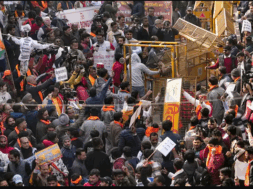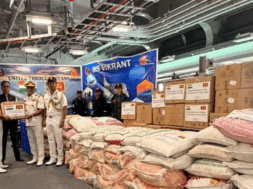
Disaster: Mountain collapses, burying 2,000 alive in Papua New Guinea
Virendra Pandit
New Delhi: The Papua New Guinea National Disaster Center said on Monday that last Friday past midnight’s massive landslide in a remote village in the northern part of the country buried over 2,000 people alive.
“The landslide buried more than 2,000 people alive and caused major destruction to buildings, and food gardens and caused a major impact on the economic lifeline of the country,” Lusete Laso Mana, Acting Director of the National Disaster Centre, said in a letter to the UN, the media reported, as survivors recounted the horror losing so many loved ones.
The landslide, caused by a mountain collapse because of extremely heavy rains, occurred in the Enga region in northern Papua New Guinea in the South-West Pacific Ocean near Australia, and the latest missing figure is a sharp rise from earlier estimates of nearly 670 people’s deaths.
Residents reeled after tonnes of rock and several feet of mud smashed into their hundreds of homes as they slept. Rescuers struggled to reach such a remote part of what is already one of Asia’s poorest nations leaving locals with little choice but to dig through the collapsed mountainside with whatever tools they have.
A surviving woman, Evit Kambum, said she had lost more than a dozen family members in the disaster.
“I have 18 of my family members buried under the debris and soil that I am standing on and a lot more family members in the village I cannot count,” she was quoted as saying. “I am the landowner here… but I cannot retrieve the bodies so I am standing here helplessly.”
Miok Michael, a local community leader, said “People have been digging since day one but can’t locate bodies as they are covered by huge rocks. Only machines will do.”
Mana said, “The situation remains unstable as the landslip continues to shift slowly, posing an ongoing danger to both rescue teams and survivors alike,” adding the main highway to the area had been completely blocked by the landslide.
Chris Jensen, PNG National Director of World Vision, said that rescue workers “clearly realized the scale of the devastation.”
“This is a landslide of massive proportion. It’s quite astonishing – a whole mountain literally fell on so many households during the middle of the night.”
“We can’t create further problems with land… so we really got to be very careful about the response now,” Jensen said.
Justine McMahon, PNG Country Director for the global humanitarian agency CARE International, said the full death toll “was still unknown because only a few bodies had been recovered.”
“The authorities have been very effective and responsive and are working around the clock… but I think given the scale of this disaster and the (numbers of) people affected, there will be resources needed from the wider aid community,” McMahon said, adding “a great challenge today is that the ground is still quite unstable.”
“Given that houses were buried under up to 8 meters of dirt (more than 26 feet), it will be difficult to reach some of the victims,” McMahon said.
Serhan Aktoprak from the UN agency, International Organization for Migration (IOM), said that rescue teams on the ground were “trying to rescue whatever they can by using digging sticks, spades, agricultural forks and their hands.”
The landslide hit the remote village of Kaokalam, about 600 km northwest of the capital Port Moresby, at around 3 am. local time on Friday, leaving a scar of debris that humanitarian workers said was as big as four football pitches.
More than 150 houses in Yambali village were buried in debris. The area is extremely risky as rocks continue to fall and the ground soil is exposed to constant increased pressure.
Papua New Guinea is home to around 10 million people. Its vast mountainous terrain and lack of roads have made it difficult to access the affected area.
Experts said the disaster could have been caused by unseasonal “considerable rainfall,” which could have altered the minerals making the bedrock, weakening the rock that forms the steep hillsides.














